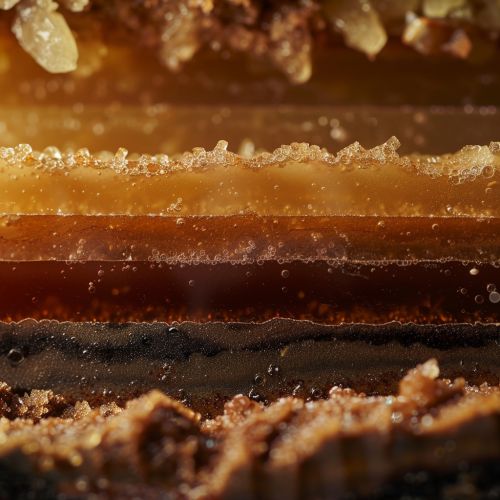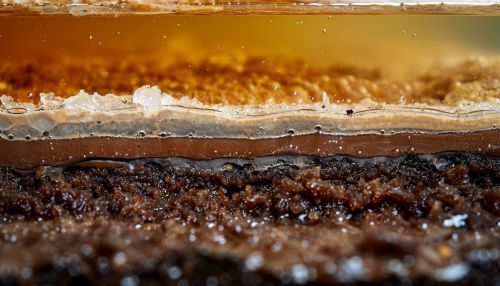Heterogeneous Mixture: Difference between revisions
(Created page with "== Definition == A Heterogeneous Mixture is a type of mixture in which the components can be visually distinguished. Unlike a homogeneous mixture, the substances do not form a single, uniform phase. Instead, they maintain their own physical properties and can often be separated by physical means. == Characteristics == Heterogeneous mixtures are characterized by the non-uniform distribution of their components. This means...") |
No edit summary |
||
| Line 5: | Line 5: | ||
Heterogeneous mixtures are characterized by the non-uniform distribution of their components. This means that the different substances that make up the mixture are not evenly spread throughout the mixture. For example, in a mixture of sand and water, the sand particles will settle at the bottom of the container, creating a separate layer from the water. | Heterogeneous mixtures are characterized by the non-uniform distribution of their components. This means that the different substances that make up the mixture are not evenly spread throughout the mixture. For example, in a mixture of sand and water, the sand particles will settle at the bottom of the container, creating a separate layer from the water. | ||
[[Image:Detail-77861.jpg|thumb|center|A close-up image of a heterogeneous mixture, showing the distinct layers of different substances.|class=only_on_mobile]] | |||
[[Image:Detail-77862.jpg|thumb|center|A close-up image of a heterogeneous mixture, showing the distinct layers of different substances.|class=only_on_desktop]] | |||
Heterogeneous mixtures can be composed of solids, liquids, or gases. The components can be of different states of matter. For example, a salad is a heterogeneous mixture of solid vegetables, while a glass of soda is a heterogeneous mixture of liquid water and gaseous carbon dioxide. | Heterogeneous mixtures can be composed of solids, liquids, or gases. The components can be of different states of matter. For example, a salad is a heterogeneous mixture of solid vegetables, while a glass of soda is a heterogeneous mixture of liquid water and gaseous carbon dioxide. | ||
Latest revision as of 02:52, 8 May 2024
Definition
A Heterogeneous Mixture is a type of mixture in which the components can be visually distinguished. Unlike a homogeneous mixture, the substances do not form a single, uniform phase. Instead, they maintain their own physical properties and can often be separated by physical means.
Characteristics
Heterogeneous mixtures are characterized by the non-uniform distribution of their components. This means that the different substances that make up the mixture are not evenly spread throughout the mixture. For example, in a mixture of sand and water, the sand particles will settle at the bottom of the container, creating a separate layer from the water.


Heterogeneous mixtures can be composed of solids, liquids, or gases. The components can be of different states of matter. For example, a salad is a heterogeneous mixture of solid vegetables, while a glass of soda is a heterogeneous mixture of liquid water and gaseous carbon dioxide.
Classification
Heterogeneous mixtures can be classified into two main types: suspensions and colloids.
Suspensions
A suspension is a type of heterogeneous mixture where solid particles are dispersed in a liquid or gas. The particles in a suspension are larger than those in a solution or colloid, and they will eventually settle out due to gravity. Examples of suspensions include orange juice with pulp and dust in air.
Colloids
A colloid is a type of heterogeneous mixture where one substance is dispersed evenly throughout another. The particles in a colloid are smaller than those in a suspension, but larger than those in a solution. They do not settle out and cannot be separated by filtration. Examples of colloids include milk, fog, and whipped cream.
Separation Techniques
There are several techniques that can be used to separate the components of a heterogeneous mixture. These techniques often involve exploiting the physical properties of the components, such as their size, density, or solubility.
Filtration
Filtration is a separation technique that is used to separate solids from liquids or gases. It involves passing the mixture through a filter that allows the liquid or gas to pass through, but traps the solid particles. This technique is commonly used in water purification processes.
Decantation
Decantation is a separation technique that is used to separate a liquid from a solid or two immiscible liquids. It involves carefully pouring off the liquid layer from the top, leaving the solid or the denser liquid behind. This technique is often used in wine making to separate the wine from the sediment.
Centrifugation
Centrifugation is a separation technique that is used to separate components of a mixture based on their size, shape, and density. It involves spinning the mixture at high speed, causing the denser particles to move towards the outside of the container. This technique is commonly used in laboratories to separate cells from a liquid medium.
Applications
Heterogeneous mixtures are found in many areas of daily life and industry. For example, many foods and beverages are heterogeneous mixtures, including salads, sandwiches, and fizzy drinks. In the construction industry, concrete is a heterogeneous mixture of cement, sand, and gravel. In the pharmaceutical industry, pills are often heterogeneous mixtures of active ingredients and fillers.
